Many believe dogs were domesticated from wolves over 15,000 years ago. But what happens when the undomesticated wolf is bred with a dog?
The German Shepherd Wolf Mix is one beautiful example. Sometimes known as a Wolf Shepherd this powerful breed is not for beginners. It needs lots of exercise, training, and socializing.
So what is a German Shepherd Wolf Mix? This breed is exactly what the name sounds like — half German Shepherd and half Eurasian Wolf.
In this article, we share everything you need to know about the breed, their history, temperament, and personality, as well as their exercise, socializing, and training requirements.
TABLE OF CONTENTS
- German Shepherd Wolf Mix Quick Summary
- German Shepherd Wolf Mix Parent Breeds
- German Shepherd Wolf Mix Physical Characteristics
- German Shepherd Wolf Mix Temperament
- German Shepherd Wolf Mix Puppies
- German Shepherd Wolf Mix Care Guide
- German Shepherd Wolf Hybrid Health Issues
- FAQs on German Shepherd Wolf Mix
- A Rare Hybrid with Unique Needs
- Other German Shepherd and Eurasian Wolf Mixes
German Shepherd Wolf Mix Quick Summary
German Shepherd Wolf Mix Parent BreedsFrom Adobe Stock
From Adobe Stock
The German Shepherd Wolf Mix combines the best traits of attributes of a German Shepherd and Wolf. This mix carries strong wolf-like features and is often mistaken for a wild Wolf. Hence, to further understand this dog’s wild Wolf characteristics, we must take a closer look at both parent breeds.
The Wolf
From Adobe Stock
Origin
The wolf, an emblematic figure in the wilderness, has a storied history that dates back millions of years. As a key species in the ecosystem, wolves have adapted to various habitats across the globe. The interbreeding of wolves with domestic dogs, such as the German Shepherd, has led to the emergence of unique hybrid breeds.
Physical Characteristics
Wolves, particularly the Eurasian Wolf and the Carpathian Wolf, are known for their impressive physical attributes. These species exhibit a robust build, keen senses, and a thick fur coat that helps them survive in harsh climates. The Eurasian Wolf is widespread across Europe and Asia, while the Carpathian Wolf, known for its specific breeding with the Husky to create the Czechoslovakian Wolfdog, hails from the Carpathian Mountain regions.
Temperament and Behavior
Wolves, including the Eurasian and Carpathian species, are characterized by their strong work ethic and hunting instincts. In the wild, they are diligent and skilled hunters, working in packs to track and capture their prey. This natural behavior underlines their teamwork, intelligence, and adaptability.
However, it’s important to note that wolves are a wild predatory species, and this aspect greatly influences their temperament. They have a complex social structure and communicate effectively within their packs, but adapting to a human environment is a different challenge altogether. Unlike domesticated dogs, wolves retain a level of unpredictability and are very hard to socialize with in a man-made environment.
Efforts to fully domesticate a wild wolf have not been successful, highlighting the distinct divide between domesticated dogs and their wild ancestors. This inherent wildness and unpredictability are essential considerations when discussing wolf-dog hybrids like the German Shepherd Wolf Mix.
The German Shepherd
From Adobe Stock
Origin
The German Shepherd, a breed synonymous with loyalty and courage, has a rich history that dates back to the late 19th Century. Initially bred for herding and guarding sheep, their versatility quickly made them a favorite for various roles beyond pastoral duties.
Physical Characteristics
Wolf-like in appearance, the German Shepherd boasts a striking figure. It was first bred in 1899 by Max von Stephanitz, who was captivated by their strength, intelligence, and beauty. German Shepherds are a prestigious dog breed, known for their robust build, alert ears, and a bushy tail that curves gracefully downwards. Their double coat, which can vary in color from tan and black to sable, provides them with ample protection against harsh weather.
Temperament and Behavior
German Shepherds are renowned for their protective instincts and intelligence. They exhibit a confident demeanor, often perceived as aloof or reserved, especially around strangers. This trait, coupled with their strong work ethic, makes them popular with police and military forces worldwide. Despite their serious work roles, they are incredibly loyal and develop strong bonds with their families.
Their ability to be easily trained and domesticated has also led to a growing popularity as a family dog. This versatility in adapting to both demanding work environments and cozy home settings makes the German Shepherd not just a working breed, but also a loving companion. Their loyalty and protective nature make them excellent pets for active households, where their energy and intelligence can be positively channeled.
German Shepherd Wolf Mix Physical Characteristics
From Adobe Stock
Unlike most hybrid dogs, identifying a German Shepherd Wolf Mix is very easy. This dog is more wolf-like than any other domesticated dog.
The German Shepherd shares many similar physical features to the Wolf and therefore this mix does too. Despite having a smaller head than a wild Wolf, they are otherwise very similar with brown and almond-shaped eyes and ears that sit on the top of their head.
Most hybrid dogs appear more like one of their parents. However, both breeds in this case look similar to a Wolf. Your puppy is guaranteed to appear strong, well-built, and athletic.
Size
This Wolf hybrid is classified as a large dog breed that will weigh anywhere between 50 to 120 pounds. Their large weight variation is because of the size difference in both parent breeds and the height range of the Wolf family. Your dog won’t grow above a height of 24 inches from the withers. As with most breeds, females tend to be smaller in size and weight than males.
Coat Color
This wolf mix typically inherits their wolf parent’s coat. They commonly have a wolf-like double-coat that is thick, and slightly coarse.
Historically their coat helps to protect them from harsh weather conditions and protects their skin from debris. Many dogs have double coats as it is an adaption to the wild that is still carried by many domesticated breeds.
The German Shepherd can come in many different colors (e.g. blue and black). But, similar to their Wolf ancestors, the German Shepherd Wolf Mix mostly comes in tones of sable to white or even black – similar to their Wolf ancestors.
They are frequent to moderate shedders. Their shedding frequency will increase during any seasonal changes. For example, they shed more frequently in spring than in winter as they begin to prepare for the hotter climate.
German Shepherd Wolf Mix Temperament
From Adobe Stock
A domesticated dog (such as the German shepherd) has a very different personality from a wild wolf. It is therefore very tricky to predict what personality traits your hybrid will have.
The temperament of the German Shepherd Wolf Hybrid can only be described as unpredictable – this is especially true in frightening or new situations.
Because of their Wolf instincts, they may be aggressive and react unpredictably when they feel threatened. These instincts can be slightly modified through early socialization as a young puppy, but this will be difficult for new owners. This is a breed that’s also very protective and therefore correct introductions with other people and pets are necessary.
The German Shepherd Wolf Hybrid is known for howling. It should come as no surprise due to their pack animal instinct inherited from wolves. Howling is one of the most common forms of wolf-to-wolf communication. Unnecessary and problematic howling may arise if this breed is left alone for prolonged periods. This trait makes this dog undesirable to busy individuals.
This dog also has a very high prey drive. Therefore, we do not recommend them living in homes with smaller animals such as cats, rabbits, or hamsters. They may get along with other dogs, but they should be watched and introduced to other dogs at a young age.
Getting close to this breed takes a lot of time and patience. Nevertheless, play is a great way to bond with your puppy, exhaust their energy, and decrease their stress levels. They are known to be quite shy at first. Eventually, the German Shepherd’s domesticated personality takes over.
The German Shepherd Wolf Mix thrives as a family companion and they are usually very loving towards their family members.
German Shepherd Wolf Mix Puppies
From Adobe Stock
This puppy typically costs $800 to $1,000.
Because this breed is very rare, its price is entirely dependent upon the breeder and not buyer demand, as it is with most dog breeds.
Experienced breeders who have bred multiple generations of German shepherd Wolf mix dogs are likely to charge $1,000. Each litter normally has six puppies. This is based on the average litter size of a wolf being four to six puppies and a German Shepherd’s eight puppies.
After adopting your puppy at eight weeks of age, the following ten weeks are a very important socialization window. Being an unpredictable and part-wolf mix, you should expect to spend lots of time training and socializing your puppy.
German Shepherd Wolf Mix Care Guide
From Adobe Stock
Caring for a half-wild Wolf mix is not easy and quickly becomes very time-consuming as this dog needs lots of socializing to try and make them more predictable. Further, his breed requires a well-structured exercise regime, continuous training, and a well-balanced diet.
Feeding
Growing up with a German Shepherd, I understand the importance of a balanced diet and proper nutrition in maintaining the health and well-being of these magnificent animals. This knowledge is particularly relevant when caring for a German Shepherd Wolf Mix, a breed that combines the traits of domestic dogs and wild wolves.
The dog was domesticated around 130,000 years ago. Since domestication an entire industry producing food emerged and many dogs eat a dry kibbled diet. However, the Wolf is still a wild species and thrives on raw meat.
So, what food should you feed your dog? A raw meat-based diet provides your dog with the necessary protein and fats.
Feeding Schedule
Feeding a German Shepherd Wolf Mix requires a well-thought-out schedule to maintain their health and energy levels. Ideally, they should be fed twice a day – once in the morning and once in the evening. This schedule helps prevent bloating and ensures a steady energy supply throughout the day. Puppies may require more frequent feedings, typically three to four times a day, to support their rapid growth and development.
Portion Control
Portion control is crucial for the German Shepherd Wolf Mix. Overfeeding can lead to obesity, while underfeeding can result in nutritional deficiencies. The exact portion depends on the dog’s age, size, activity level, and overall health. It’s advisable to follow the guidelines provided on dog food packaging as a starting point and adjust as necessary. Regular check-ups with a vet can also help in determining the ideal portion size for your specific dog.
Treats and Snacks
While treats and snacks can be a useful tool in training and bonding, they should be given in moderation. Treats should not constitute more than 10% of the dog’s daily caloric intake. Choose healthy options like lean meats, fruits, and vegetables that are safe for dogs. Avoid human snacks, as many can be harmful to canines.
Special Dietary Considerations
Given their unique genetic makeup, German Shepherd Wolf Mixes may have specific dietary needs. They often thrive on high-quality, protein-rich dog foods that cater to large, active breeds. Some may benefit from a diet that includes raw meat, mimicking the diet of their wolf ancestors, but this should be discussed with a vet to ensure it meets all nutritional requirements and is safe.
Hydration
Adequate hydration is as important as proper nutrition. Always ensure your German Shepherd Wolf Mix has access to fresh, clean water. Their water intake may vary depending on their diet, activity level, and environmental conditions. Monitoring their water consumption is essential, especially in hot weather or after intense exercise, to prevent dehydration.
Training and Exercise
Exercise Requirements
This is a breed with high exercise requirements. Leaving them to exercise on their own in a backyard is not an option. They require well-structured exercise routines to help burn off all of their energy.
Wolves are known to walk up to eight hours per day.
Hence, running or long hikes are great ways to exercise a German Shepherd Wolf Mix. You will need lots of control of your dog when walking in public – they will be a handful without a leash.
Training Tips
This mix is an intelligent breed. However, this does not guarantee that training will be easy. Intelligence is only one attribute that makes a dog trainable. Temperament and willingness to please are also important attributes for training.
This breed is independent, unpredictable, and stubborn. Therefore, patience and constant training are very important. Hence, we would only recommend this breed for an experienced owner who can provide positive reinforcement and routine.
Socializing your German Shepherd Wolf Mix is essential and will form an important part of training because this dog is half wild and half domesticated. They also have strong predatory and protective instincts that will need socializing at a young age.
Mental Stimulation
This head-strong hybrid, inheriting the intelligence and energy of both the German Shepherd and the wolf, requires regular mental engagement to stay balanced and happy. Without adequate mental stimulation, such as dog tricks training, they can easily become bored, leading to potentially destructive behavior.
To effectively stimulate their minds, it’s important to incorporate a variety of activities that challenge them both intellectually and physically. Puzzle toys that require problem-solving to access treats can be particularly beneficial. These toys not only keep them occupied but also hone their cognitive skills.
Structured and unstructured playtimes are essential. Allowing them to explore new environments during walks or hikes can keep their minds stimulated and curious. This exploration taps into their instincts and provides mental stimulation that is both enriching and satisfying.
Grooming
As someone who grew up with a German Shepherd and experienced firsthand the importance of regular grooming, I can’t stress enough how crucial it is to understand and implement proper grooming practices for a German Shepherd Wolf Mix. Starting grooming routines at a young age is especially important for this hybrid, as wolves are not naturally accustomed to human contact or grooming.
Brushing
Regular brushing is essential for the German Shepherd Wolf Mix, thanks to their beautifully thick fur! Their coat is prone to matting and shedding as it’s a blend of the dense fur of the wolf and the German Shepherd’s double coat.
We recommend brushing your dog every second day to help manage shedding, prevent tangles, and keep their coat shiny and healthy. Regular brushing from a young age not only helps in maintaining their coat but also acclimatizes them to being handled, which is particularly important for a breed with wild instincts.
Bathing
Bathing a German Shepherd Wolf Mix should be done as needed, typically not more than once a month, unless they get particularly dirty. Over-bathing can strip their coat of natural oils, leading to dry skin. Use a dog-specific shampoo that’s gentle on their skin and coat.
Nail Trimming
Keeping their nails trimmed is also important for their comfort and health. Long nails can cause discomfort and even lead to problems with walking. Depending on their activity level, their nails may need to be trimmed every month or two.
Ear and Teeth Cleaning
Regular ear checks and cleaning are important to prevent infections, especially considering their floppy ears. Teeth should be brushed regularly to maintain dental health and prevent tartar buildup. Starting these routines early in life will make these processes easier as they grow.
Professional Grooming
Finally, while much of the grooming can be done at home, occasional visits to a professional groomer can be beneficial. They can handle the more challenging aspects of grooming and check for any skin or coat issues that might require attention.
Incorporating these grooming practices into your routine will not only keep your German Shepherd Wolf Mix looking their best but also provide an opportunity to strengthen your bond with them. As with my own German Shepherd, these moments of care can become a cherished part of your relationship with your pet.
German Shepherd Wolf Hybrid Health Issues
The German Shepherd Wolf Hybrid has a life expectancy of between 9 and 13 years. It’s closer to a German Shepherd’s lifespan of 9 to 14 years rather than a wild Wolf’s of just 8 years.
Unfortunately, due to genetics inherited from their German Shepherd parent, they are predisposed to genetic health problems, including the following.
Hip Dysplasia
As someone experienced with German Shepherds, I’m well aware that hip dysplasia is a common concern in this breed, and it extends to the German Shepherd Wolf Mix. This genetic condition, where the hip joint doesn’t fit together perfectly, can lead to arthritis and lameness. It’s often exacerbated by the rapid growth they experience as puppies. Regular vet check-ups, maintaining a healthy weight, and appropriate exercise can help manage this condition.
Degenerative Myelopathy
Degenerative Myelopathy, a progressive disease of the spinal cord, is particularly prevalent in German Shepherds and can affect their mixes. This condition typically appears in older dogs, leading to paralysis in the hind limbs. While there’s no cure, early diagnosis and supportive care can help maintain quality of life. Watching for early signs like loss of coordination in the hind legs is important.
Bloat
Bloat, or gastric dilatation-volvulus (GDV), is a life-threatening condition often seen in large, deep-chested breeds like the German Shepherd Wolf Mix. It occurs when the stomach fills with gas and twists, preventing blood flow. Immediate veterinary intervention is crucial. Preventative measures include feeding smaller, more frequent meals and avoiding vigorous exercise around meal times.
Allergies
This mix breed can also inherit allergies, either environmental or food-related, common in German Shepherds. Symptoms can range from skin irritations to gastrointestinal issues. Identifying and managing allergens, whether through dietary changes or environmental adjustments, is key. Regular vet visits and possibly allergy testing can help in managing this condition effectively.
Eye Problems
Lastly, eye problems such as cataracts or progressive retinal atrophy can occur in this breed. Regular eye examinations are important for early detection and treatment. Maintaining regular check-ups and watching for signs like cloudiness in the eyes or changes in vision can help in early intervention.
FAQs on German Shepherd Wolf Mix
Are they good family dogs?
No. We would also not recommend keeping a German Shepherd Wolf Hybrid in a home with small children. They are not patient. They should be monitored carefully and introduced to young children from a very young age. This will help them to feel comfortable.
They are beautiful companions and can be very loving and loyal to their immediate family. However, their wolf instincts and unpredictability mean they are better suited to a home without other pets.
What is the lifespan of a German Shepherd Wolf Mix?
The lifespan of a German Shepherd Wolf Mix typically ranges between 9 and 13 years. This, of course, can vary depending on genetics, health conditions, and the quality of care they receive throughout their life, including diet, exercise, and regular veterinary check-ups.
How much exercise does a German Shepherd Wolf Mix need?
A German Shepherd Wolf Mix requires significant amounts of exercise to keep them physically and mentally stimulated. They thrive on activities like long walks, hikes, and play sessions. Ideally, they should get at least 1-2 hours of exercise daily. It’s important to provide them with a variety of activities to prevent boredom and maintain their health.
Can German Shepherd Wolf Mixes be trained easily?
German Shepherd Wolf Mixes are intelligent and can be trained, but they can also inherit the wolf’s strong-willed nature, making training more challenging. Consistency, patience, and positive reinforcement techniques are key. Starting training and socialization at a young age is crucial for their development.
How big do German Shepherd Wolf Mixes get?
German Shepherd Wolf Mixes are generally large dogs. Males can weigh between 50 to 90 pounds and stand 24 to 26 inches tall at the shoulder, while females are slightly smaller. Their size can vary greatly depending on which traits they inherit more from – the German Shepherd or the Wolf.
Are German Shepherd Wolf Mixes legal to own?
The legality of owning a German Shepherd Wolf Hybrid varies by location. Many states and countries have specific regulations or bans on owning Wolf-dog hybrids due to their unpredictable nature. It’s important to check local laws and regulations before considering adopting one of these hybrids.
What kind of diet is best for a German Shepherd Wolf Mix?
A balanced diet rich in protein is ideal for a German Shepherd Wolf Mix. High-quality commercial dog food that is suitable for large breeds can be a good choice. Some owners also opt for a raw diet, which should be discussed with a veterinarian to ensure it meets all nutritional requirements. Portion control and regular feeding schedules are important to prevent obesity and other health issues.
A Rare Hybrid with Unique Needs
This breed is visually striking and possesses a unique set of characteristics that potential owners should be well aware of. Before adopting this mix, it’s crucial to understand the commitment required in terms of socialization, training, and exercise. They need an owner who can provide consistent guidance, patience, and a structured environment.
In return for the right care and attention, a German Shepherd Wolf Mix can be an incredibly loyal, protective, and intelligent companion. They are playful and have a certain level of unpredictability, which can be appealing to some but also signifies a significant responsibility for the owner.
Owning a German Shepherd Wolf Mix is legally restricted in many states due to their complex needs and the challenges they can present, especially regarding training and socialization. Because of these factors, this breed is generally recommended for experienced dog owners only.
What do you think of mixing a domesticated canine with the wild Wolf? Give us your thoughts below!
Other German Shepherd and Eurasian Wolf Mixes
If you’re interested in learning about other German Shepherd mixes or Eurasian mixes, check out the hybrid dog breeds below.
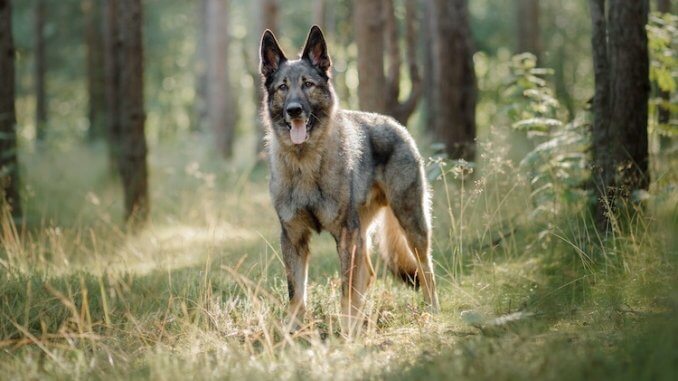
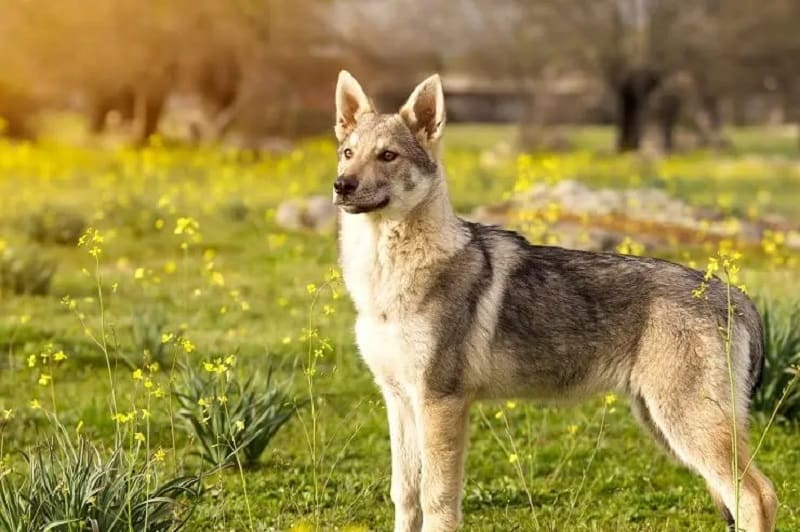
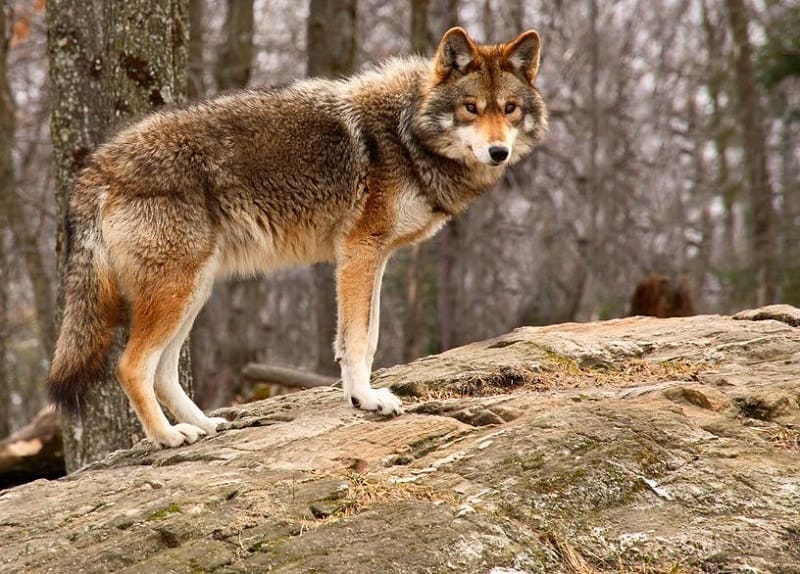
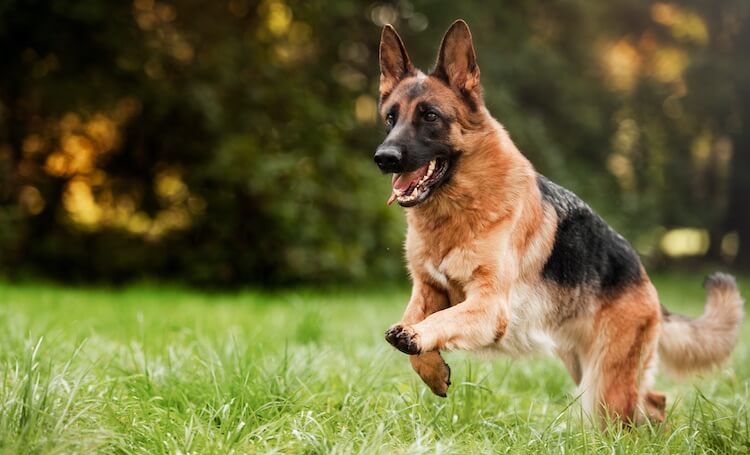
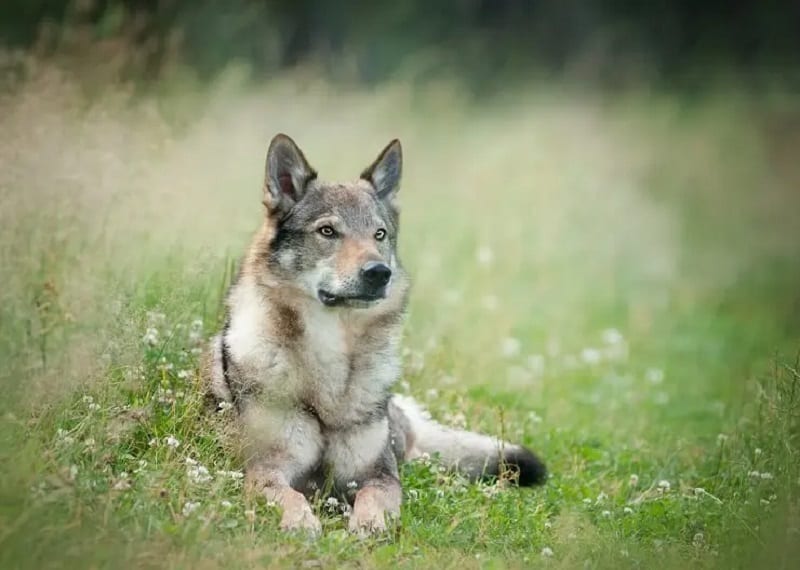
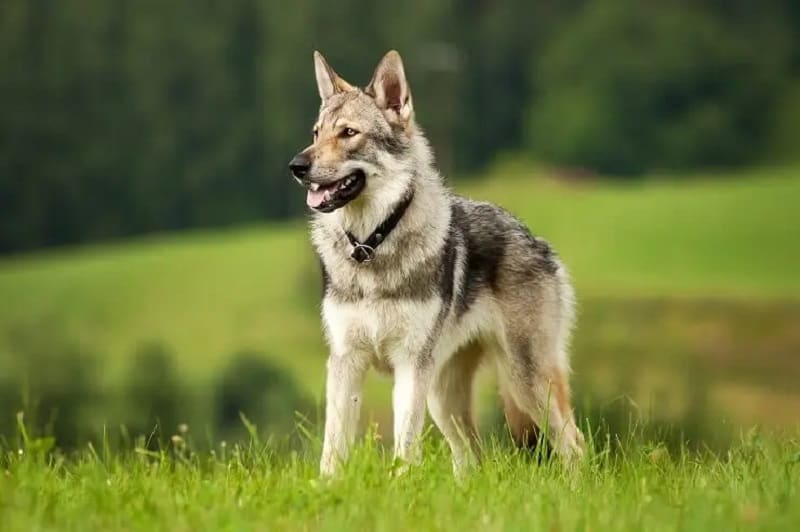

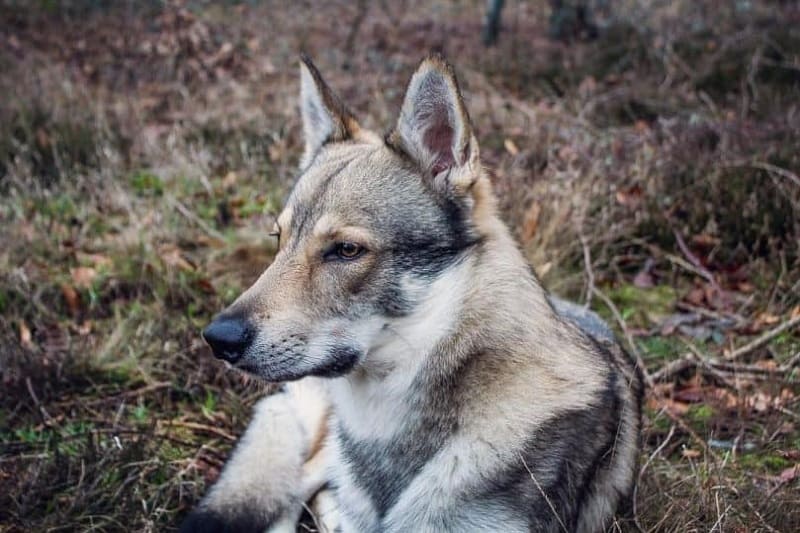

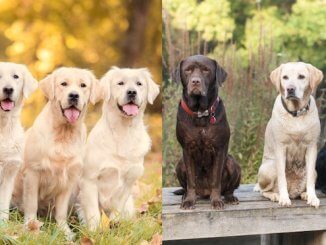
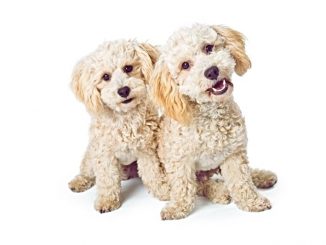

I am the former owner of a German Shepherd/Wolf mix dog, or canine. He was extremely beautiful with tan, and black and silver coloring. I am a woman, he loved women, loved my pretty women friends. He just ignored older of not-so-pretty women and girls! SO shallow! He also loved my husband whom I married after Paddy was a year old. He had extremely thick, fluffy stand-up ears, not near as big as a Shepherds ears, but thick, fluffy and very pretty. We had a big black fluffy long haired male (fixed) cat who Paddy frequently tried to play with, but Blackie wouldn’t have it! He almost never barked, but he howled alot. Some of that came from the nearness of a full-blood female white Wolf who lived one block over. She was crazy about him every time she saw him. He acted embarassed by her overt displays to him. Her family moved to an acreage outside of the City because they had to get rid of her or move! I can understand why, she was only Wolf,no dog in her. Paddy DID NOT, ever, have that sweet ‘dog-look’ in his eyes, ever. I missed that in him. But he was very kind, and funny to me. He liked raw meat far more than Dog Food, and he would never touch a piece of candy or a slice of toast or a cookie. No refined carbs for him. His one evil-food-pleasure was a slice of Pizza if he could get it. Here is a funny routine that he had for me: he LOVED homemade vegetable soup poured over his dry dog food. If I gave him that for dinner he would follow us to the Livingroom after dinner and want me to set alone in the center of the sofa. If I took to much time doing it, as in talking to my husband while I stood by the sofa he would jump-up and push me unto the sofa. Then, standing right in front of me…he would grab the tip of his ultra-thick, coarse haired-tail and start turning himself in a tight circle. One front paw was placed over his tail, the other one helped with balance. I could see his teeth clamped down tightly on his tail! He would spin and my husband and I would clap in time to his spins! If he turned 22 times to the Right then he would stop and spin 22 times to the Left! The times might change, like 14 times to the Right, then 14 times to the Left. We thought that this preformance of his might have been like a “thank-you” treat for me for giving him soup or stew on top of his dry food. That was something that I usually did once or twice a week. He wanted to perform this dance-spin and he wanted me to set down to see it! He was a full time house-dog, and was usually walked 2 or 3 times a day. We brushed him every other day, he shed all the time. His hair/fur was very coarse and thick and he would NOT let us brush him in the house, that had to be done on the open front porch! It seemed like he wanted the other dogs in the block to see him getting ‘beautified’! Other dogs hated him and would attack him if they could. He was never violent towards any other animals. One curious thing about him…he never smelled “doggy”, not his body or his breath. He smelled MINTY! His breath, his hair/fur, he always smelled like mint!? He lived to 14 years. I still miss him.
That was beautiful!
That was a beautiful tribute to your wolf dog. I enjoyed reading it.
Just wondering if neutering would calm the aggressive I’ve heard about.